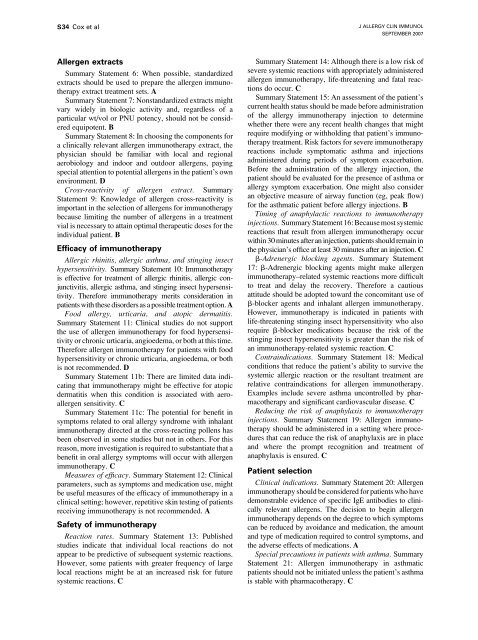Immunotherapy Safety for the Primary Care ... - U.S. Coast Guard
Immunotherapy Safety for the Primary Care ... - U.S. Coast Guard
Immunotherapy Safety for the Primary Care ... - U.S. Coast Guard
Create successful ePaper yourself
Turn your PDF publications into a flip-book with our unique Google optimized e-Paper software.
S34 Cox et al<br />
J ALLERGY CLIN IMMUNOL<br />
SEPTEMBER 2007<br />
Allergen extracts<br />
Summary Statement 6: When possible, standardized<br />
extracts should be used to prepare <strong>the</strong> allergen immuno<strong>the</strong>rapy<br />
extract treatment sets. A<br />
Summary Statement 7: Nonstandardized extracts might<br />
vary widely in biologic activity and, regardless of a<br />
particular wt/vol or PNU potency, should not be considered<br />
equipotent. B<br />
Summary Statement 8: In choosing <strong>the</strong> components <strong>for</strong><br />
a clinically relevant allergen immuno<strong>the</strong>rapy extract, <strong>the</strong><br />
physician should be familiar with local and regional<br />
aerobiology and indoor and outdoor allergens, paying<br />
special attention to potential allergens in <strong>the</strong> patient’s own<br />
environment. D<br />
Cross-reactivity of allergen extract. Summary<br />
Statement 9: Knowledge of allergen cross-reactivity is<br />
important in <strong>the</strong> selection of allergens <strong>for</strong> immuno<strong>the</strong>rapy<br />
because limiting <strong>the</strong> number of allergens in a treatment<br />
vial is necessary to attain optimal <strong>the</strong>rapeutic doses <strong>for</strong> <strong>the</strong><br />
individual patient. B<br />
Efficacy of immuno<strong>the</strong>rapy<br />
Allergic rhinitis, allergic asthma, and stinging insect<br />
hypersensitivity. Summary Statement 10: <strong>Immuno<strong>the</strong>rapy</strong><br />
is effective <strong>for</strong> treatment of allergic rhinitis, allergic conjunctivitis,<br />
allergic asthma, and stinging insect hypersensitivity.<br />
There<strong>for</strong>e immuno<strong>the</strong>rapy merits consideration in<br />
patients with <strong>the</strong>se disorders as a possible treatment option. A<br />
Food allergy, urticaria, and atopic dermatitis.<br />
Summary Statement 11: Clinical studies do not support<br />
<strong>the</strong> use of allergen immuno<strong>the</strong>rapy <strong>for</strong> food hypersensitivity<br />
or chronic urticaria, angioedema, or both at this time.<br />
There<strong>for</strong>e allergen immuno<strong>the</strong>rapy <strong>for</strong> patients with food<br />
hypersensitivity or chronic urticaria, angioedema, or both<br />
is not recommended. D<br />
Summary Statement 11b: There are limited data indicating<br />
that immuno<strong>the</strong>rapy might be effective <strong>for</strong> atopic<br />
dermatitis when this condition is associated with aeroallergen<br />
sensitivity. C<br />
Summary Statement 11c: The potential <strong>for</strong> benefit in<br />
symptoms related to oral allergy syndrome with inhalant<br />
immuno<strong>the</strong>rapy directed at <strong>the</strong> cross-reacting pollens has<br />
been observed in some studies but not in o<strong>the</strong>rs. For this<br />
reason, more investigation is required to substantiate that a<br />
benefit in oral allergy symptoms will occur with allergen<br />
immuno<strong>the</strong>rapy. C<br />
Measures of efficacy. Summary Statement 12: Clinical<br />
parameters, such as symptoms and medication use, might<br />
be useful measures of <strong>the</strong> efficacy of immuno<strong>the</strong>rapy in a<br />
clinical setting; however, repetitive skin testing of patients<br />
receiving immuno<strong>the</strong>rapy is not recommended. A<br />
<strong>Safety</strong> of immuno<strong>the</strong>rapy<br />
Reaction rates. Summary Statement 13: Published<br />
studies indicate that individual local reactions do not<br />
appear to be predictive of subsequent systemic reactions.<br />
However, some patients with greater frequency of large<br />
local reactions might be at an increased risk <strong>for</strong> future<br />
systemic reactions. C<br />
Summary Statement 14: Although <strong>the</strong>re is a low risk of<br />
severe systemic reactions with appropriately administered<br />
allergen immuno<strong>the</strong>rapy, life-threatening and fatal reactions<br />
do occur. C<br />
Summary Statement 15: An assessment of <strong>the</strong> patient’s<br />
current health status should be made be<strong>for</strong>e administration<br />
of <strong>the</strong> allergy immuno<strong>the</strong>rapy injection to determine<br />
whe<strong>the</strong>r <strong>the</strong>re were any recent health changes that might<br />
require modifying or withholding that patient’s immuno<strong>the</strong>rapy<br />
treatment. Risk factors <strong>for</strong> severe immuno<strong>the</strong>rapy<br />
reactions include symptomatic asthma and injections<br />
administered during periods of symptom exacerbation.<br />
Be<strong>for</strong>e <strong>the</strong> administration of <strong>the</strong> allergy injection, <strong>the</strong><br />
patient should be evaluated <strong>for</strong> <strong>the</strong> presence of asthma or<br />
allergy symptom exacerbation. One might also consider<br />
an objective measure of airway function (eg, peak flow)<br />
<strong>for</strong> <strong>the</strong> asthmatic patient be<strong>for</strong>e allergy injections. B<br />
Timing of anaphylactic reactions to immuno<strong>the</strong>rapy<br />
injections. Summary Statement 16: Because most systemic<br />
reactions that result from allergen immuno<strong>the</strong>rapy occur<br />
within 30 minutes after an injection, patients should remain in<br />
<strong>the</strong> physician’s office at least 30 minutes after an injection. C<br />
b-Adrenergic blocking agents. Summary Statement<br />
17: b-Adrenergic blocking agents might make allergen<br />
immuno<strong>the</strong>rapy–related systemic reactions more difficult<br />
to treat and delay <strong>the</strong> recovery. There<strong>for</strong>e a cautious<br />
attitude should be adopted toward <strong>the</strong> concomitant use of<br />
b-blocker agents and inhalant allergen immuno<strong>the</strong>rapy.<br />
However, immuno<strong>the</strong>rapy is indicated in patients with<br />
life-threatening stinging insect hypersensitivity who also<br />
require b-blocker medications because <strong>the</strong> risk of <strong>the</strong><br />
stinging insect hypersensitivity is greater than <strong>the</strong> risk of<br />
an immuno<strong>the</strong>rapy-related systemic reaction. C<br />
Contraindications. Summary Statement 18: Medical<br />
conditions that reduce <strong>the</strong> patient’s ability to survive <strong>the</strong><br />
systemic allergic reaction or <strong>the</strong> resultant treatment are<br />
relative contraindications <strong>for</strong> allergen immuno<strong>the</strong>rapy.<br />
Examples include severe asthma uncontrolled by pharmaco<strong>the</strong>rapy<br />
and significant cardiovascular disease. C<br />
Reducing <strong>the</strong> risk of anaphylaxis to immuno<strong>the</strong>rapy<br />
injections. Summary Statement 19: Allergen immuno<strong>the</strong>rapy<br />
should be administered in a setting where procedures<br />
that can reduce <strong>the</strong> risk of anaphylaxis are in place<br />
and where <strong>the</strong> prompt recognition and treatment of<br />
anaphylaxis is ensured. C<br />
Patient selection<br />
Clinical indications. Summary Statement 20: Allergen<br />
immuno<strong>the</strong>rapy should be considered <strong>for</strong> patients who have<br />
demonstrable evidence of specific IgE antibodies to clinically<br />
relevant allergens. The decision to begin allergen<br />
immuno<strong>the</strong>rapy depends on <strong>the</strong> degree to which symptoms<br />
can be reduced by avoidance and medication, <strong>the</strong> amount<br />
and type of medication required to control symptoms, and<br />
<strong>the</strong> adverse effects of medications. A<br />
Special precautions in patients with asthma. Summary<br />
Statement 21: Allergen immuno<strong>the</strong>rapy in asthmatic<br />
patients should not be initiated unless <strong>the</strong> patient’s asthma<br />
is stable with pharmaco<strong>the</strong>rapy. C
















